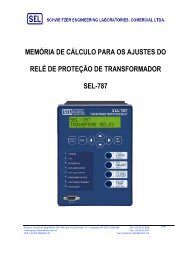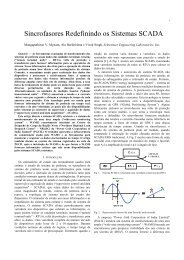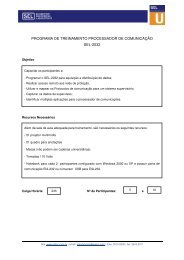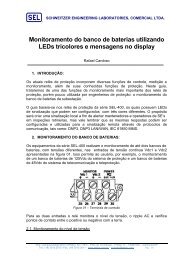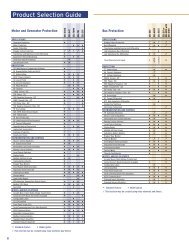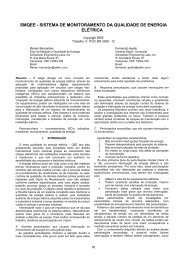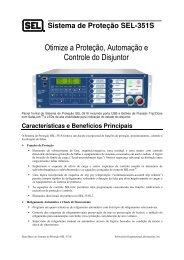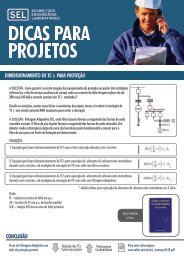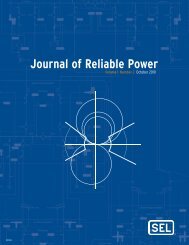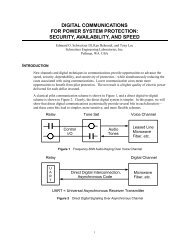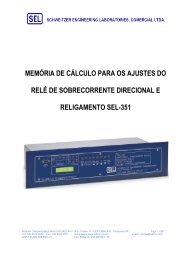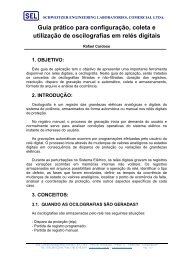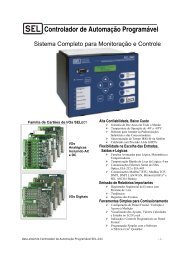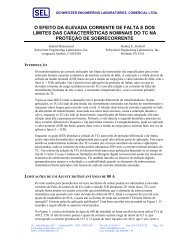Journal of Reliable Power - SEL
Journal of Reliable Power - SEL
Journal of Reliable Power - SEL
Create successful ePaper yourself
Turn your PDF publications into a flip-book with our unique Google optimized e-Paper software.
One-Cycle Directional Element<br />
Figure 2<br />
A-Phase One-Cycle<br />
Fault Selection<br />
A-Phase-to-Ground<br />
One-Cycle Mho Element<br />
High-Speed Directional<br />
HSD-AGF<br />
A-Phase-to-Ground<br />
Half-Cycle Mho Element<br />
A-Phase-to-Ground<br />
Fault Detector-MAG<br />
A-Phase Impedance Loop Half- and One-Cycle Combination Logic<br />
B. High-Speed Distance Element Performance<br />
As an example, Figure 3 shows the two calculations <strong>of</strong> the<br />
distance m for a long line (in a 50 Hz system), Zone 2 A-<br />
phase-to-ground fault occurring at 0.1 s in a system with an<br />
SIR = 0.2. In this case, the half-cycle signal detects the fault at<br />
0.111 s and the one-cycle signal detects the fault at 0.123 s.<br />
The half-cycle element detects the fault 12 ms faster than the<br />
one-cycle element.<br />
m calculation (pu)<br />
2<br />
1.5<br />
1<br />
0.5<br />
Figure 3<br />
m half-cycle<br />
detection<br />
Zone 2 reach = r<br />
m one-cycle<br />
detection<br />
Fault<br />
inception<br />
0<br />
0.05 0.1 0.15 0.2<br />
Time (Seconds)<br />
m Calculations for a Zone 2 A-Phase-to-Ground Fault<br />
For the same example as the Zone 2 A-phase-to-ground<br />
fault shown in Figure 3, the timing <strong>of</strong> the different half-cycle<br />
and one-cycle signals is shown in Figure 4. The HSD-FTS<br />
signal (HSD-AGF in this case) occurs first (this signal has a<br />
duration <strong>of</strong> two cycles because it is based on superimposed<br />
quantities). After a few milliseconds, the half-cycle mho<br />
element (MHO-AGH) follows. More than a half-cycle later,<br />
we have the one-cycle mho (MHO-AGF) detection.<br />
Because the mho-detector signals are “ORed”, the time<br />
occurrence <strong>of</strong> the final fault detection MHO-AG corresponds<br />
to the fast detection MHO-AGH. In this case, we achieve an<br />
improvement, typical in practically all cases, <strong>of</strong> about one<br />
half-cycle. Two cycles after the fault inception, the detection<br />
depends only upon the one-cycle derived signals.<br />
HSD-AGF<br />
MHO-AGH<br />
MHO-AGF<br />
MHO-AG<br />
0 0.05 0.1 0.15 0.2<br />
Time (Seconds)<br />
Figure 4<br />
A-Phase-to-Ground Zone 2 Fault Signals<br />
III. SERIES COMPENSATION OVERREACHING<br />
PROBLEMS AND SOLUTION<br />
Series capacitors applied on transmission systems improve<br />
system stability and increase power transfer capability. The<br />
application <strong>of</strong> a series capacitor reduces the inductive<br />
reactance <strong>of</strong> the given transmission line, making the line<br />
appear electrically shorter. Although series capacitors may<br />
improve power system operation, using these capacitors<br />
results in a challenging problem for impedance-based line<br />
protection.<br />
Adding series capacitors on a transmission line causes<br />
subharmonic transients to occur following faults or switching<br />
<strong>of</strong> the series capacitor. These subharmonics can cause<br />
underreaching Zone 1 distance elements to overreach for<br />
external faults. There are other problems associated with<br />
subsynchronous resonance in generators. In this paper, we<br />
focus on problems associated with distance relays.<br />
All series capacitors come equipped with protective<br />
elements that reduce or eliminate over-voltages across the<br />
capacitor. The protection may be as simple as a spark gap set<br />
to flashover at a given voltage or as elaborate as metal-oxide<br />
varistors (MOV) using complex energy monitoring schemes.<br />
In any case, operation <strong>of</strong> the series capacitor protection<br />
elements can either remove the series capacitor completely or<br />
change capacitive reactance in a nonlinear fashion.<br />
The simplest series capacitor protection scheme removes<br />
the series capacitor when the series capacitor voltage exceeds<br />
a set threshold. The use <strong>of</strong> a spark gap protection scheme can<br />
simplify use <strong>of</strong> underreaching distance relays on seriescompensated<br />
lines. Firing <strong>of</strong> the spark gap for external faults<br />
may prevent Zone 1 overreach, so it is then possible to ignore<br />
the series capacitor. In most applications, however, the spark<br />
gap firing voltage threshold is high enough that the spark gap<br />
does not fire for external faults.<br />
MOVs present an interesting challenge because this type <strong>of</strong><br />
protection scheme does not fully remove the series capacitor.<br />
In fact, the capacitive reactance can be very nonlinear. We can<br />
use an iterative model [16] to approximate the effective<br />
reactance <strong>of</strong> the MOV-protected bank. However, this model<br />
does not provide insight about the transient response. Some<br />
MOV-protected capacitor banks include energy monitoring <strong>of</strong><br />
the MOVs. Bypassing <strong>of</strong> the capacitor bank occurs when the<br />
energy level exceeds a specified threshold. This can work to<br />
our advantage when we use impedance-based schemes.<br />
In either case, we need careful analysis and study before<br />
applying any impedance-based protection scheme on seriescompensated<br />
lines.<br />
A. Distance Relay Overreaching Problems<br />
The series connection <strong>of</strong> the capacitor, the transmission<br />
line, and the system source create a resonant RLC circuit. The<br />
natural frequency <strong>of</strong> the circuit is a function <strong>of</strong> the level <strong>of</strong><br />
compensation and the equivalent power system source. The<br />
level <strong>of</strong> compensation can change according to the switching<br />
in and out <strong>of</strong> series capacitor “segments.” The source<br />
impedance can change because <strong>of</strong> switching operations<br />
external to the protected line section.<br />
Transmission Line Protection System for Increasing <strong>Power</strong> System Requirements | 43



